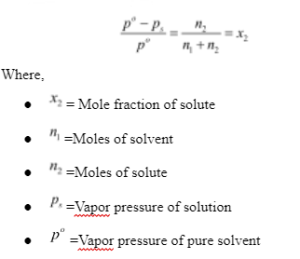The partial vapour pressure of a component in an ideal mixture is equal to the vapour pressure of the pure component multiplied by its mole fraction, according to Raoult’s law.
An ideal mixture assumes that all molecules in the mixture have equal intermolecular interactions.
Mathematically, it can be shown as:
Where,
is the vapour pressure of the solution
is the mole fraction of the solvent
is the vapour pressure of pure solvent.
For a solution consists of two components A and B, the equation can be given as:
Also, we know that;
Where,
is the mole fraction of component A
is the mole fraction of component B
is the vapor pressure of component A
is the vapour pressure of component B
is the total vapor pressure
Raoult’s law for Non-Volatile solutes
The relative drop in vapour pressure in a solution containing a non-volatile solute equals the mole fraction of the non-volatile solute in the solution, according to Raoult’s law.
The equation can be given as:
Where,
= Mole fraction of solute
=Moles of solvent
=Moles of solute
=Vapor pressure of solution
=Vapor pressure of pure solvent
Why we observe this effect?
The molecules on the surface cause the drop in vapour pressure as the solute concentration rises. All the molecules on the surface of a pure solvent are solvent molecules. These are the surface molecules that will dissolve into the vapour phase. There are fewer solvent molecules on the surface to escape to the vapour phase as the solute concentration rises. Solute molecules have taken up some of those surface patches. The entire vapour pressure is reduced as a result.
Limitations of the law
Raoult’s law is particularly applicable since it describes ideal solutions, that is, those in which the gas phase possesses thermodynamic parameters comparable to a mixture of ideal gases. The only issue is that they are uncommon and tough to come by. Chemical equivalency between distinct chemical components is required.
Because many liquid combinations have differing attractive forces, many solutions depart from Raoult’s law. Hence, do not obey it correctly.
Deviation from Raoult’s law
A positive deviation indicates that the vapour pressure above the solution is higher than expected. A negative divergence, on the other hand, indicates that the solution’s vapour pressure is lower than expected.
Positive deviation with an example
When the partial pressure of component ‘A’ in the mixture of ‘A’ and ‘B’ is found to be greater than that calculated from Raoult’s law in non-ideal solutions. Similar to Raoult’s law, the partial vapour pressure of component ‘B’ can be higher than calculated.
Water and ethanol, chloroform and water, ethanol and , benzene and methanol, acetic acid and toluene, acetone and ethanol, methanol and
are examples of positive divergence from Raoult’s law.
for positive deviation.
Negative deviation with an example
On adding the second component ‘B’, the partial vapour pressure of component ‘A’ is found to be smaller than calculated from Raoult’s law. When A is mixed with B, the partial vapour pressure of the solution falls below that of an ideal solution with the same composition.
The boiling point of such a solution is slightly higher than that of A and B, respectively.
Negative departure from Raoult’s rule describes this type of deviation from ideal behaviour.
Examples include chlorofom and acetone, chloroform and methyl acetate, and
,
and
, acetic acid and pyridine, and chloroform and benzene.
for negative deviation
Positively skewed non-ideal solutions | Negatively skewed non-ideal solutions |
The attractive forces between solute-solvent molecules are less than those between solute-solute and solvent-solvent molecules, i.e. | The intermolecular attractive forces between solute-solvent molecules are stronger than those between solute-solute and solvent-solvent molecules, i.e. |
Reason for deviation
The hydrogen bonding between the molecules causes a positive divergence in Raoult’s law. The attraction between the molecules in the solution is increased by these hydrogen bonds. As a result, the solution’s vapour pressure exceeds the calculation. The attraction between the molecules is lessened when the deviation is negative.
Conclusion
Perfect solutions have the same intermolecular interactions as pure components and the same thermodynamic mixing qualities as perfect distinct gases.
Perfect solutions come from the intermolecular forces between molecules of pure substances being equivalent to the forces between molecules of one and molecules of the other.
Raoult’s law is especially useful since it defines ideal solutions or those in which the gas phase has thermodynamic properties that are comparable to a combination of ideal gases.
 Profile
Profile Settings
Settings Refer your friends
Refer your friends Sign out
Sign out













